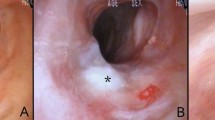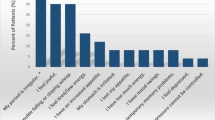Abstract
Purpose
Our previous study on the idiopathic progressive subglottic stenosis (IPSS) highlighted a possible hormonal mechanism, with over-expression of estrogen receptors alpha (ER-α) and progesterone receptors (PR). We tested whether such over-expression take place in non-idiopathic subglottic stenosis (NISS) as well.
Methods
37 specimens of iatrogenic NISS were analyzed (20 females; mean age, 59 ± 12 years; range 41–85). Immunoreactivity of ER-α and PR was calculated as the product of intensity (1 = weak, 2 = moderate, 3 = strong) and positive cells percentage (1 to 4, for < 10%, 10–50%, 50–80%, and > 80%). This score was calculated on the stenotic tissue (ST), and stenosis margins (SM).
Results
The expression of PR was significantly higher in ST of IPSS compared with female and male NISS patients (8.7 ± 3.1 vs. 4.9 ± 3.2, p < 0.001 for IPSS vs. female and 8.7 ± 3.1 vs. 2.1 ± 2.7, p < 0.01 for IPSS vs. male NISS patients). Contrarily, ER-α showed gender differences, as both IPSS and female NISS patients had similar, yet higher ER-α expression compared with male NISS patients (7.0 ± 4.2 vs. 6.5 ± 2.5, p = NS for IPSS vs. female and 7.0 ± 4.2 vs. 3.4 ± 2.0, p < 0.02 for IPSS vs. male NISS patients). There was no difference in fibroblast receptor expression between ST and SM. However, ER-α and PR expression was significantly lower in marginal mucous glands when compared with ST.
Conclusions
The IPSS pathogenesis appears to be driven by hormonal mechanisms, in particular, by over-expression of PR. Marginal cells display a reduced hormone receptor density. This finding could be interpreted as a compensatory mechanism. These findings could open up for targeted IPSS treatment.
Similar content being viewed by others
References
Gelbard A, Francis DO, Sandulache VC, Simmons JC, Donovan DT, Ongkasuwan J (2015) “Causes and consequences of adult laryngotracheal stenosis,” (in eng). Laryngoscope 125(5):1137–1143. https://doi.org/10.1002/lary.24956
Nouraei SA, Singh A, Patel A, Ferguson C, Howard DJ, Sandhu GS (2006) “Early endoscopic treatment of acute inflammatory airway lesions improves the outcome of postintubation airway stenosis,” (in eng). Laryngoscope 116(8):1417–1421. https://doi.org/10.1097/01.mlg.0000225377.33945.14
Qiu XJ, Zhang J, Wang T, Pei YH, Xu M (2015) “Nonstent combination interventional therapy for treatment of benign cicatricial airway stenosis,” (in eng). Chin Med J (Engl) 128(16):2154–2161. https://doi.org/10.4103/0366-6999.162496
Esteller-Moré E, Ibañez J, Matiñó E, Ademà JM, Nolla M, Quer IM (2005) “Prognostic factors in laryngotracheal injury following intubation and/or tracheotomy in ICU patients,” (in eng). Eur Arch Otorhinolaryngol 262(11):880–883. https://doi.org/10.1007/s00405-005-0929-y
Lorenz RR (2003) “Adult laryngotracheal stenosis: etiology and surgical management,” (in eng). Curr Opin Otolaryngol Head Neck Surg 11(6):467–472. https://doi.org/10.1097/00020840-200312000-00011
Hseu AF, Benninger MS, Haffey TM, Lorenz R (2014) Subglottic stenosis: a ten-year review of treatment outcomes. Laryngoscope 124(3):736–741. https://doi.org/10.1002/lary.24410
Kettunen WW, Helmer SD, Haan JM (2014) “Incidence of overall complications and symptomatic tracheal stenosis is equivalent following open and percutaneous tracheostomy in the trauma patient,” (in eng). Am J Surg 208(5):770–774. https://doi.org/10.1016/j.amjsurg.2013.12.036
Reidenbach MM, Schmidt HM (1995) “Anatomical aspects of postintubational subglottic stenosis,” (in eng). Clin Anat 8(4):273–280. https://doi.org/10.1002/ca.980080406
Sarper A, Ayten A, Eser I, Ozbudak O, Demircan A (2005) “Tracheal stenosis aftertracheostomy or intubation: review with special regard to cause and management,” (in eng). Tex Heart Inst J 32(2):154–158
Damrose EJ (2008) “On the development of idiopathic subglottic stenosis,” (in eng). Med Hypotheses 71(1):122–125. https://doi.org/10.1016/j.mehy.2007.12.017
Blumin JH, Johnston N (2011) “Evidence of extraesophageal reflux in idiopathic subglottic stenosis,” (in eng). Laryngoscope 121(6):1266–1273. https://doi.org/10.1002/lary.21776
Gelbard A et al (2017) “Molecular analysis of idiopathic subglottic stenosis for Mycobacterium species,” (in eng). Laryngoscope 127(1):179–185. https://doi.org/10.1002/lary.26097
Hillel AT et al (2019) “Laryngotracheal Microbiota in Adult Laryngotracheal Stenosis,” (in eng). mSphere. https://doi.org/10.1128/mSphereDirect.00211-19
Drake VE et al (2020) “Familial Aggregation in Idiopathic Subglottic Stenosis,” (in eng). Otolaryngol Head Neck Surg 163(5):1011–1017. https://doi.org/10.1177/0194599820935402
Davis RJ et al (2021) “Increased Expression of PD-1 and PD-L1 in Patients With Laryngotracheal Stenosis,” (in eng). Laryngoscope 131(5):967–974. https://doi.org/10.1002/lary.28790
Dedo HH, Catten MD (2001) “Idiopathic progressive subglottic stenosis: findings and treatment in 52 patients,” (in eng). Ann Otol Rhinol Laryngol 110(4):305–311. https://doi.org/10.1177/000348940111000403
Valdez TA, Shapshay SM (2002) “Idiopathic subglottic stenosis revisited,” (in eng). Ann Otol Rhinol Laryngol 111(8):690–695. https://doi.org/10.1177/000348940211100806
Fiz I et al (2018) “Hormone receptors analysis in idiopathic progressive subglottic stenosis,” (in eng). Laryngoscope 128(2):E72-e77. https://doi.org/10.1002/lary.26931
Chang E et al (2019) “Iatrogenic subglottic tracheal stenosis after tracheostomy and endotracheal intubation: a cohort observational study of more severity in keloid phenotype,” (in eng). Acta Anaesthesiol Scand 63(7):905–912. https://doi.org/10.1111/aas.13371
Remmele W, Stegner HE (1987) Recommendation for uniform definition of an immunoreactive score (IRS) for immunohistochemical estrogen receptor detection (ER-ICA) in breast cancer tissue. Pathologe 8(3):138–140 (Vorschlag zur einheitlichen Definition eines Immunreaktiven Score (IRS) fur den immunhistochemischen Ostrogenrezeptor-Nachweis (ER-ICA) im Mammakarzinomgewebe)
Hillel AT, Ding D, Samad I, Murphy MK, Motz K (2019) “T-Helper 2 Lymphocyte Immunophenotype Is Associated With Iatrogenic Laryngotracheal Stenosis,” (in eng). Laryngoscope 129(1):177–186. https://doi.org/10.1002/lary.27321
Mack M (2018) “Inflammation and fibrosis,” (in eng). Matrix Biol 68–69:106–121. https://doi.org/10.1016/j.matbio.2017.11.010
Aravena C et al (2020) “Idiopathic subglottic stenosis: a review,” (in eng). J Thorac Dis 12(3):1100–1111. https://doi.org/10.21037/jtd.2019.11.43
Ebada HA, El-Fattah AMA, Tawfik A (2021) “Revision cricotracheal resection: our experience,” (in eng). J Laryngol Otol 135(1):57–63. https://doi.org/10.1017/s0022215121000062
Fiz I et al (2018) “Predictors of recurrence after surgical treatment of idiopathic progressive subglottic stenosis,” (in eng). Acta Otorhinolaryngol Ital 38(5):417–423. https://doi.org/10.14639/0392-100x-1872
Fiz I et al (2020) “Multicentric study applying the european laryngological society classification of benign laryngotracheal stenosis in adults treated by tracheal or cricotracheal resection and anastomosis,” (in eng). Laryngoscope 130(7):1640–1645. https://doi.org/10.1002/lary.28274
Kovats S (2015) “Estrogen receptors regulate innate immune cells and signaling pathways,” (in eng). Cell Immunol 294(2):63–69. https://doi.org/10.1016/j.cellimm.2015.01.018
Ghisletti S, Meda C, Maggi A, Vegeto E (2005) “17beta-estradiol inhibits inflammatory gene expression by controlling NF-kappaB intracellular localization,” (in eng). Mol Cell Biol 25(8):2957–2968. https://doi.org/10.1128/mcb.25.8.2957-2968.2005
Vegeto E et al (2010) “Estrogen receptor-alpha as a drug target candidate for preventing lung inflammation,” (in eng). Endocrinology 151(1):174–184. https://doi.org/10.1210/en.2009-0876
Yakimchuk K, Jondal M, Okret S (2013) “Estrogen receptor α and β in the normal immune system and in lymphoid malignancies,” (in eng). Mol Cell Endocrinol 375(1–2):121–129. https://doi.org/10.1016/j.mce.2013.05.016
Kastner P et al (1990) “Two distinct estrogen-regulated promoters generate transcripts encoding the two functionally different human progesterone receptor forms A and B,” (in eng). Embo j 9(5):1603–1614
Patel BG, Rudnicki M, Yu J, Shu Y, Taylor RN (2017) “Progesterone resistance in endometriosis: origins, consequences and interventions,” (in eng). Acta Obstet Gynecol Scand 96(6):623–632. https://doi.org/10.1111/aogs.13156
Acknowledgements
The authors have no funding, financial relationship, or conflicts of interest to disclose
Author information
Authors and Affiliations
Corresponding author
Additional information
Publisher's Note
Springer Nature remains neutral with regard to jurisdictional claims in published maps and institutional affiliations.
Rights and permissions
Springer Nature or its licensor holds exclusive rights to this article under a publishing agreement with the author(s) or other rightsholder(s); author self-archiving of the accepted manuscript version of this article is solely governed by the terms of such publishing agreement and applicable law.
About this article
Cite this article
Fiz, I., Antonopoulos, W., Kölmel, JC. et al. Hormone pathway comparison in non-idiopathic and idiopathic progressive subglottic stenosis. Eur Arch Otorhinolaryngol 280, 775–780 (2023). https://doi.org/10.1007/s00405-022-07615-0
Received:
Accepted:
Published:
Issue Date:
DOI: https://doi.org/10.1007/s00405-022-07615-0




